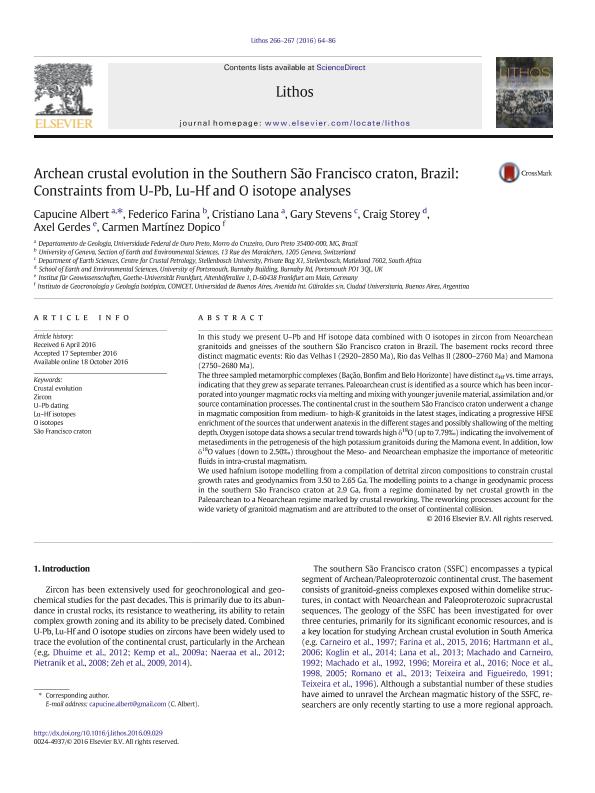Mostrar el registro sencillo del ítem
dc.contributor.author
Albert, Capucine
dc.contributor.author
Farina, Federico
dc.contributor.author
Lana, Cristiano
dc.contributor.author
Stevens, Gary
dc.contributor.author
Storey, Craig
dc.contributor.author
Gerdes, Axel
dc.contributor.author
Martínez Dopico, Carmen Irene

dc.date.available
2017-06-16T15:48:19Z
dc.date.issued
2016-12
dc.identifier.citation
Albert, Capucine; Farina, Federico; Lana, Cristiano; Stevens, Gary; Storey, Craig; et al.; Archean crustal evolution in the Southern São Francisco craton, Brazil: constraints from U-Pb, Lu-Hf and O isotope analyses; Elsevier Science; Lithos; 266-267; 12-2016; 64-86
dc.identifier.issn
0024-4937
dc.identifier.uri
http://hdl.handle.net/11336/18308
dc.description.abstract
In this study we present U–Pb and Hf isotope data combined with O isotopes in zircon from Neoarchean granitoids and gneisses of the southern São Francisco craton in Brazil. The basement rocks record three distinct magmatic events: Rio das Velhas I (2920–2850 Ma), Rio das Velhas II (2800–2760 Ma) and Mamona (2750–2680 Ma). The three sampled metamorphic complexes (Bação, Bonfim and Belo Horizonte) have distinct εHf vs. time arrays, indicating that they grew as separate terranes. Paleoarchean crust is identified as a source which has been incorporated into younger magmatic rocks via melting and mixing with younger juvenile material, assimilation and/or source contamination processes. The continental crust in the southern São Francisco craton underwent a change in magmatic composition from medium- to high-K granitoids in the latest stages, indicating a progressive HFSE enrichment of the sources that underwent anatexis in the different stages and possibly shallowing of the melting depth. Oxygen isotope data shows a secular trend towards high δ18O (up to 7.79‰) indicating the involvement of metasediments in the petrogenesis of the high potassium granitoids during the Mamona event. In addition, low δ18O values (down to 2.50‰) throughout the Meso- and Neoarchean emphasize the importance of meteoritic fluids in intra-crustal magmatism. We used hafnium isotope modelling from a compilation of detrital zircon compositions to constrain crustal growth rates and geodynamics from 3.50 to 2.65 Ga. The modelling points to a change in geodynamic process in the southern São Francisco craton at 2.9 Ga, from a regime dominated by net crustal growth in the Paleoarchean to a Neoarchean regime marked by crustal reworking. The reworking processes account for the wide variety of granitoid magmatism and are attributed to the onset of continental collision.
dc.format
application/pdf
dc.language.iso
eng
dc.publisher
Elsevier Science

dc.rights
info:eu-repo/semantics/openAccess
dc.rights.uri
https://creativecommons.org/licenses/by-nc-nd/2.5/ar/
dc.subject
Crustal Evolution
dc.subject
Zircon
dc.subject
U-Pb Dating
dc.subject
Lu-Hf Isotopes
dc.subject
O Isotopes
dc.subject
Sao Francisco Craton
dc.subject.classification
Geoquímica y Geofísica

dc.subject.classification
Ciencias de la Tierra y relacionadas con el Medio Ambiente

dc.subject.classification
CIENCIAS NATURALES Y EXACTAS

dc.title
Archean crustal evolution in the Southern São Francisco craton, Brazil: constraints from U-Pb, Lu-Hf and O isotope analyses
dc.type
info:eu-repo/semantics/article
dc.type
info:ar-repo/semantics/artículo
dc.type
info:eu-repo/semantics/publishedVersion
dc.date.updated
2017-06-16T15:22:00Z
dc.journal.volume
266-267
dc.journal.pagination
64-86
dc.journal.pais
Países Bajos

dc.journal.ciudad
Amsterdam
dc.description.fil
Fil: Albert, Capucine. Universidade Federal de Ouro Preto; Brasil
dc.description.fil
Fil: Farina, Federico. Universidad de Ginebra; Suiza
dc.description.fil
Fil: Lana, Cristiano. Universidade Federal de Ouro Preto; Brasil
dc.description.fil
Fil: Stevens, Gary. Stellenbosch University; Sudáfrica
dc.description.fil
Fil: Storey, Craig. University of Portsmouth; Reino Unido
dc.description.fil
Fil: Gerdes, Axel. Goethe Universitat Frankfurt; Alemania
dc.description.fil
Fil: Martínez Dopico, Carmen Irene. Consejo Nacional de Investigaciones Científicas y Técnicas. Oficina de Coordinación Administrativa Ciudad Universitaria. Instituto de Geocronología y Geología Isotopica. Universidad de Buenos Aires. Facultad de Ciencias Exactas y Naturales. Instituto de Geocronología y Geología Isotopica; Argentina
dc.journal.title
Lithos

dc.relation.alternativeid
info:eu-repo/semantics/altIdentifier/doi/http://dx.doi.org/10.1016/j.lithos.2016.09.029
dc.relation.alternativeid
info:eu-repo/semantics/altIdentifier/url/http://www.sciencedirect.com/science/article/pii/S0024493716303218?via%3Dihub
Archivos asociados
